I have used Amazon affiliate links on this page. As an Amazon Associate, I earn a commission from qualifying purchases at no added cost to you. Thank you!
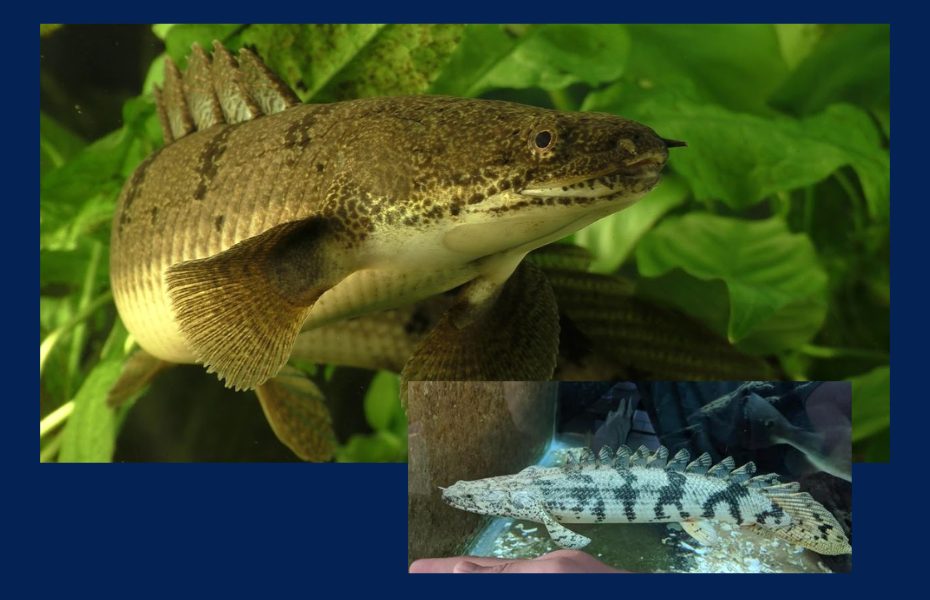
Table of Contents
Introduction
The Delhezi Bichir, also known as the barred bichir, armored bichir, bandback bichir, or banded bichir, is a rare and unique species of fish that is gaining popularity in the aquarium hobby. It is found in the upper and middle portions of the Congo River and is one of the more commonly available species in commercial pet stores. This species is named in honor of Belgian artist and naturalist Henri Paul Delhez, who collected and provided valuable information about bichirs in the Congo region. In this blog post, we’ll dive into every aspect of keeping this dianosouar looking fish healthy and long living.
The Delhezi Bichir is a species of Bichir, a family of ancient ray-finned fish that are believed to have evolved over 360 million years ago. They are often referred to as “living fossils” because they closely resemble some of the earliest known species of fish. The Delhezi Bichir is native to the Congo River basin in Central Africa and is known for its unique physical appearance, which includes a long, eel-like body and large, bony scales.
Scientific name and classification
The scientific name of the Delhezi Bichir is Polypterus delhezi. It is a species of fish that belongs to the Polypteridae family and the order Polypteriformes. The Bichirs are a group of primitive ray-finned fish that are known for their bony scales and elongated bodies, and the Delhezi Bichir is one of several species within this group.
Habitat
This fish is native to the Congo River basin in Central Africa. It is found in the upper and middle portions of the Congo River, where it inhabits slow-moving streams, swamps, and flooded forests. These ancient fish prefer murky and heavily vegetated environments, where they can hide and hunt for food.
In terms of distribution, these fish are found in the Democratic Republic of Congo, Republic of Congo, and possibly other nearby countries. The species is relatively widespread in its natural habitat, but its populations may be impacted by environmental factors such as habitat destruction and water pollution. Despite this, Delhezi Bichir is not currently listed as a least concern species by the International Union for Conservation of Nature (IUCN).
Morphology of Delhezi Bichir
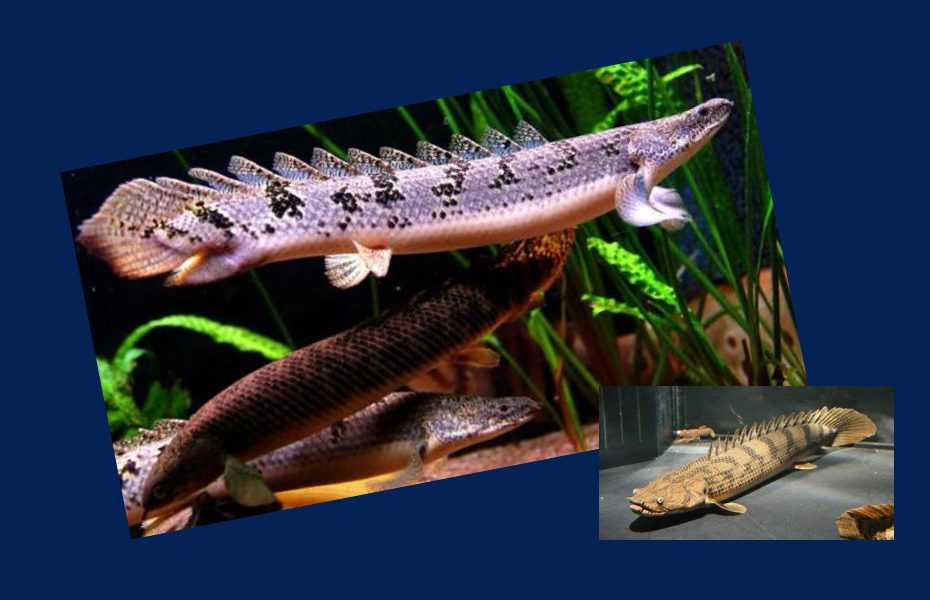
The Delhezi bichir has a subcylindrical body and upper and lower jaws that reach the same level. It has 10-13 dorsal finlets and a pectoral fin that does not reach the dorsal fin origin. The fish has ganoid scales with 52-58 lateral line scales, 36-40 scales around the body, and 12-17 predorsal scales. Its dorsal side is gray-olive colored with 7 to 8 black transversal bars, while its ventral side is yellowish and lighter on the ventral side of the head. The fins are yellow with brown or black spots.
The Delhezi Bichir is a primitive species and its distinct characteristics set it apart from its relatives. It has a cartilaginous body, similar to a shark, and its jaw bones resemble those of a salamander more than a fish. Its dorsal fin is made up of a series of individual spines that make it stand out from other fish species.
An interesting feature of the Delhezi Bichir is its modified swim bladder which also functions as a lung. This makes it the only known vertebrate to have a lung but no trachea. Its scales are primitive and are covered with a substance called “ganoin” which is similar to tooth enamel. Its scales are thicker than other types of scales and consist of a layer of dentine and ganoine, an inorganic bone salt. Each scale is shaped like a rhombus and they connect with peg-and-socket joints, making them non-overlapping with each other.
This bichir belongs to the “upper-jawed” subclass of Polypterus, meaning its upper jaw protrudes farther than its lower jaw. This cleaver-shaped jaw and maxilla bear a resemblance to early ray-finned fishes, suggesting a shared primitive condition. Its diet includes smaller animals that it is capable of sucking into its mouth.
Growth Rate, Size & Lifespan
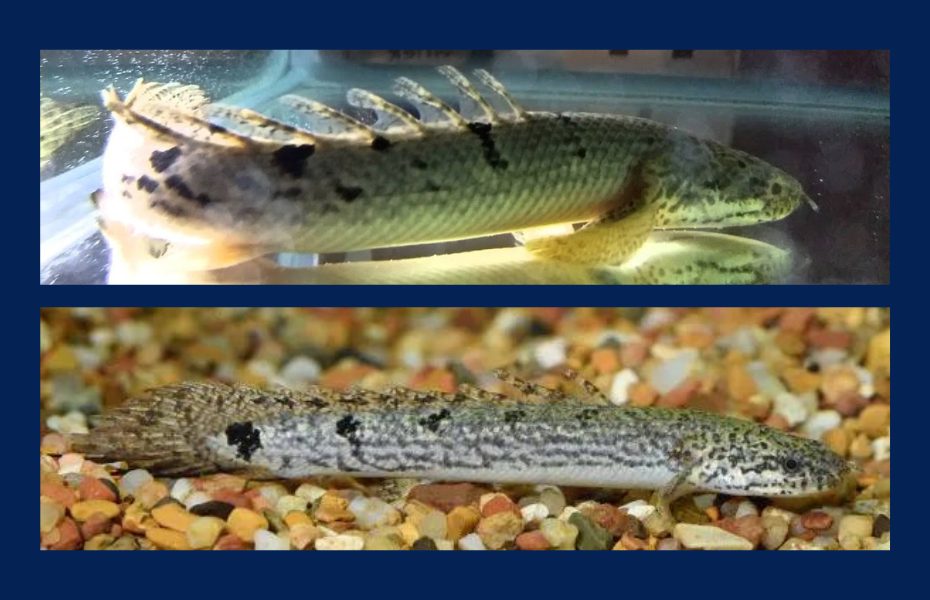
The growth rate of Delhezi Bichir can vary depending on several factors, including water quality, diet, and overall health. With proper husbandry and optimal conditions, these fish can grow at a rate of approximately half an inch to an inch per month for the first 1-2 years of their lives, reaching an average size of 12 inches. However, after reaching this size, the growth rate becomes progressively slower. It is important to provide Delhezi Bichirs with a healthy environment and diet to support their growth and overall well-being.
It is important to note that, like most fish species, this birchir grows smaller in captivity than it does in the wild. This is due to several factors, including their diet and water conditions, as well as the fact that they are often kept in smaller tanks in captivity. The average adult size of the Delhezi Bichir is up to 16 inches, but a more typical maximum size in an aquarium is 14 inches.
With proper care and maintenance, Delhezi bichirs can live for several years, with an average lifespan of about 10-15 years.
The growth rate of Delhezi bichirs can be affected by several factors, including their diet, water conditions, and overall health. In captivity, it is essential to provide them with adequate space and conditions to help them grow and thrive.
Water Parameters and Requirements
This is a relatively hardy species that can tolerate a range of water conditions. However, it’s important to provide them with water parameters that are within their preferred range to keep them healthy and thriving. Here are the recommended water parameters for Delhezi Bichir:
- pH: Delhezi Bichir prefers a slightly acidic to neutral pH of 6.5 to 7.0. It’s important to maintain a stable pH level to avoid stress.
- Temperature: The recommended water temperature for this fish is 24-26°C (75-79°F). A steady temperature should be maintained to avoid stress and prevent illness.
- Water Hardness: Delhezi Bichir can tolerate a range of water hardness levels, but it’s important to maintain stable conditions to avoid stress. A general hardness (GH) of 4-12 dGH is recommended.
- Water Quality: This is a relatively low-maintenance species, but it’s important to maintain good water quality to keep them healthy. Regular water changes and a good filtration system can help to maintain water quality.
By providing these water parameters within their preferred range, you can ensure their health and well-being in the home aquarium. It’s important to regularly test the water to monitor levels and make any necessary adjustments.
Aquarium Water Testing Kits
Aquarium Heaters
Thermometers
Aquarium Wave Makers
Diet and Feeding Habits
Delhezi Bichir is a carnivorous species that requires a diet rich in protein. In the wild, they feed on a variety of prey including small fish, crustaceans, and insects. In the home aquarium, they can be fed a variety of live, frozen, or dried foods. Here are some guidelines for feeding Delhezi Bichir:
- Frequency: This fish should be fed once or twice a day, with only enough food to last for a few minutes at each feeding. Overfeeding can lead to water quality issues and contribute to health problems.
- Variety: A varied diet is important to provide Delhezi Bichir with all the nutrients they need. Offer a variety of foods such as live or frozen shrimp, worms, small fish, and commercial carnivore pellets.
- Live Foods: Live foods such as worms and small shrimp are a great option for this fish. Live foods provide a natural diet and offer the benefits of a moving target, encouraging natural predatory behavior.
- Freeze-dried Foods: Freeze-dried foods such as krill and shrimp can also be offered as part of the diet. Freeze-dried foods are a convenient option and can be stored for long periods.
- Pellets: Commercial carnivore pellets can also be offered as part of the diet. Pellets are a balanced and convenient food source and can be used to supplement live and frozen foods.
By providing Delhezi Bichir with a varied and balanced diet, you can ensure their health and well-being in the home aquarium. It’s important to monitor their feeding behavior and adjust their diet as necessary to maintain optimal health.
Compatibility with Other Species
Delhezi Bichir is generally considered a peaceful species, but it can be aggressive towards other fish, especially those that are small or slow-moving. Here are some guidelines and things to consider when choosing tankmates for Delhezi Bichir:
- Size: This fish can grow up to 30 cm (12 inches) in length, so it’s important to choose tank mates that are a similar size or larger to avoid potential aggression.
- Temperament: This is generally a peaceful species, so it’s best to choose tank mates that are also peaceful and not overly aggressive.
- Water Requirements: It’s important to choose tank mates that have similar water requirements to Delhezi Bichir. This will help to maintain stable water conditions and prevent stress.
- Compatibility: This Bichir can coexist with other species such as larger cichlids, larger catfish, and larger tetras. However, it’s important to avoid keeping Delhezi Bichir with smaller fish or slow-moving fish, as they may become prey.
By carefully choosing tank mates, you can help to create a peaceful and harmonious community in the home aquarium. It’s important to monitor the behavior of all fish in the tank to ensure they are getting along and to address any aggression if necessary.
Aquarium Setup
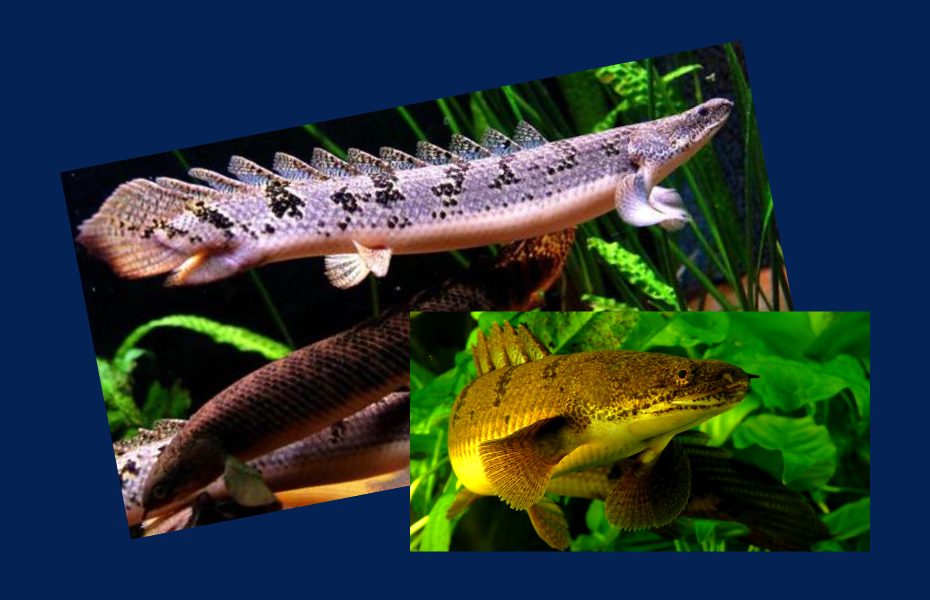
Delhezi Bichir is a relatively hardy species that can adapt to a range of aquarium conditions. However, it is important to provide them with a suitable environment that mimics their natural habitat in order to keep them healthy and thriving. Here are the key components of a suitable aquarium setup for Delhezi Bichir:
Tank Size:
The minimum recommended tank size for Delhezi Bichirs is a 75-gallon aquarium. However, it is recommended to provide a larger tank as the fish can grow up to 16 inches (41 cm) and will require a lot of swimming space. The general rule of thumb is to provide 1 to 2 gallons of water per inch of fish, so a minimum of 120-150 gallons of water should be provided to house a group of adult Delhezi Bichirs. Additionally, the tank should be decorated with plenty of hiding places and well-filtered and maintained to provide a stable and healthy environment for the fish.
Filtration:
A good filtration system is important to maintain water quality and remove waste. This Bichir produces a significant amount of waste, so it’s important to have a powerful filter that can handle the load.
Lighting:
Delhezi Bichir does not have specific lighting requirements, but it’s important to provide adequate light for plants and other aquarium inhabitants.
Substrate:
A soft, sandy substrate is ideal for Delhezi Bichir, as it will not damage their bony scales.
Decor:
Delhezi Bichir likes to hide, so it’s important to provide plenty of hiding places such as caves, rocks, and plants. Live plants are also a good choice, as they will help to maintain water quality and provide a natural environment.
Maintenance Tips For Polypterus Delhezi
This fish is a relatively low-maintenance species that is easy to care for in the home aquarium. However, it’s important to maintain a clean and stable environment to keep them healthy. Here are some key maintenance tasks:
- Water Changes: Regular water changes are important to maintain water quality and remove waste. A water change of 25% once a week is recommended.
- Cleaning: Clean the tank and filters regularly to remove waste and debris.
- Feeding: Delhezi Bichir is a carnivorous species that should be fed a variety of protein-rich foods such as live or frozen shrimp, worms, and small fish. It’s important to feed them a balanced diet and not overfeed, as this can lead to water quality issues.
By following these guidelines, you can provide a suitable environment for your Bichir and ensure their health and well-being in the home aquarium.
Reproductive Behavior and Breeding Conditions
Reproductive behavior is an important aspect of the biology of Delhezi Bichirs. Despite being one of the most commonly available species in pet stores, breeding them in captivity can be quite challenging.
In their natural habitat, these fish are known to breed during the rainy season. During this time, the males become very territorial and may exhibit aggressive behavior to protect their spawning area. The females lay their eggs in a nest that is carefully guarded by the male. The eggs are fertilized by the male, who then continues to guard the nest until the eggs hatch.
In captivity, the breeding process can be more difficult due to the specific water parameters and conditions required. The water temperature, pH, and hardness levels must be kept within a certain range, and a high level of oxygen must be maintained. In addition, the presence of suitable spawning surfaces, such as a spawning mop or a flat stone is also important for successful breeding.
One of the biggest challenges in breeding Delhezi Bichirs in captivity is getting the males and females to pair off. In many cases, the males may become aggressive towards the females, making it difficult for them to lay their eggs. In these situations, it may be necessary to separate the males and females into different tanks to avoid aggression.
Overall, breeding these amazing Bichirs can be a rewarding experience for aquarium enthusiasts, but it requires a good deal of patience and a proper understanding of the species’ biology and requirements. With the right setup and conditions, successful breeding can be achieved, resulting in the addition of a new generation of Delhezi Bichirs to the aquarium.
Potential Challenges and Solutions for Successful Breeding of Delhezi Bichir
- Water Conditions: Maintaining stable water conditions is crucial for successful breeding. Water temperature, pH, and hardness should be monitored regularly, and any fluctuations should be corrected immediately.
Solution: Using a high-quality aquarium thermometer, pH meter, and water hardness test kit can help to monitor water conditions and ensure they are within the optimal range.
- Conditioning: Delhezi Bichir requires a high-protein diet for conditioning, which can be difficult to provide in captivity.
Solution: Offer a variety of live or frozen foods, such as worms, shrimp, and small fish, to ensure Delhezi Bichir is receiving a balanced and high-protein diet.
- Spawning: Delhezi Bichir may not spawn in captivity, even if the conditions are optimal.
Solution: Provide Delhezi Bichir with plenty of hiding places and plenty of swimming space, as this can encourage spawning. Additionally, try to simulate a natural environment, such as providing low lighting and providing a flat surface for the eggs to be laid on.
- Incubation: Incubating the eggs of Delhezi Bichir can be challenging, as they are delicate and require stable water conditions.
Solution: Incubate the eggs in a separate tank with stable water conditions and maintain a consistent temperature and pH. Avoid disturbing the eggs and avoid using strong currents or filters, as this can cause harm to the eggs.
- Fry Care: Caring for the fry of Delhezi Bichir can be difficult, as they require small live or frozen foods and clean water conditions.
Solution: Provide the fry with a diet of small live or frozen foods, such as brine shrimp or bloodworms, and maintain stable water conditions. Change water regularly to keep it clean, and avoid overcrowding the fry to reduce stress and promote growth.
By addressing these potential challenges and using these solutions, it’s possible to successfully breed Delhezi Bichir in the home aquarium. However, it’s important to be patient and have experience with breeding fish, as it can be a challenging and rewarding process.
Diseases, Treatments & Prevention
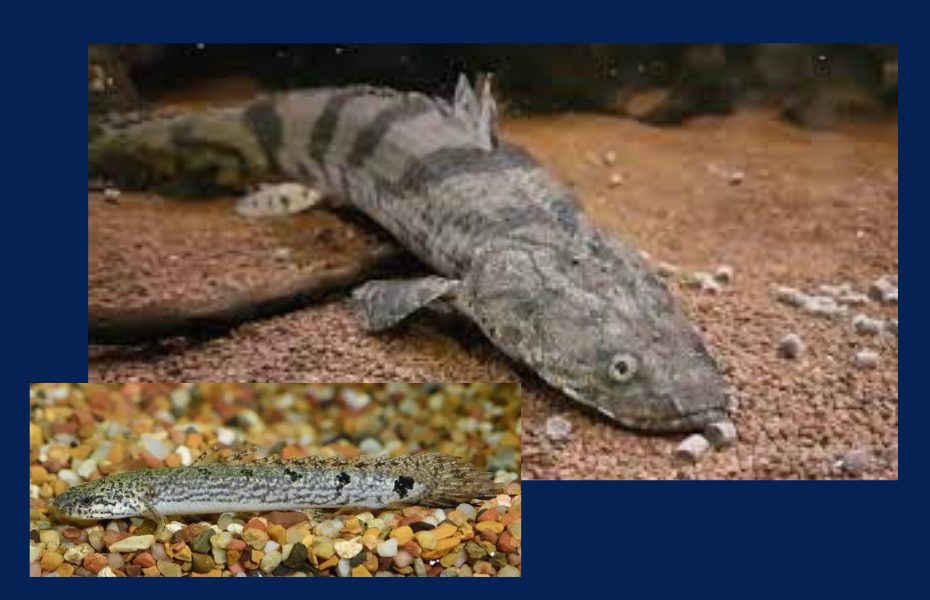
It is important to maintain proper water quality and hygiene to prevent the spread of disease. Here are some common diseases and possible treatments for Delhezi Bichirs:
- Parasitic Infections: Parasites such as Ich (Ichthyophthirius multifiliis) and flukes can cause skin irritation, loss of appetite and decreased activity. Treatment options include using a parasite treatment or removing the affected fish to a separate quarantine tank for treatment.
- Bacterial Infections: Bacterial infections can manifest as red sores, ulcers, fin rot, and cloudy eyes. Antibiotics such as Kanamycin and Nitrofuran can be used to treat bacterial infections.
- Fungal Infections: Fungal infections usually appear as a cottony growth on the skin, fins, and mouth. Anti-fungal treatments such as Methylene blue or potassium permanganate can be used to treat fungal infections.
To prevent diseases in Delhezi Bichirs, it is important to maintain proper water quality by performing regular water changes and testing the water parameters regularly. It is also advisable to quarantine new fish before introducing them to the main tank, to avoid spreading diseases. Additionally, good hygiene practices, such as cleaning and disinfecting the tank, accessories and tools, can help prevent the spread of diseases.
In conclusion, by providing proper care and maintaining good hygiene, you can reduce the risk of disease in your Delhezi Bichir aquarium and ensure the health of your fish.
Conclusion
The Delhezi Bichir is a fascinating and unique species that is well-suited for home aquariums. With its distinctive appearance and relatively low-maintenance care requirements, it is a popular choice among fish enthusiasts. While they can be a bit aggressive towards smaller fish, they are generally peaceful and can coexist with other large, compatible species. By providing a suitable environment with clean water, appropriate feeding, and adequate space, Delhezi Bichir can thrive in captivity and provide a beautiful and interesting addition to any aquarium.